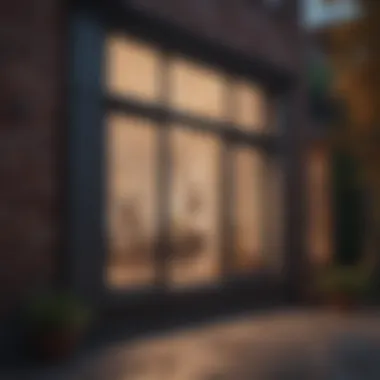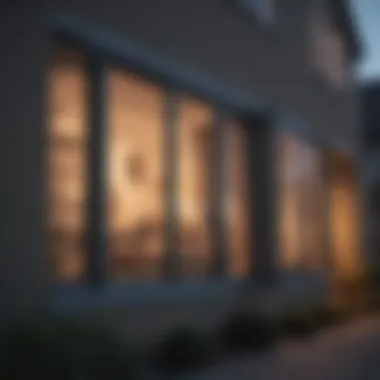Choosing the Right Window Tint for Your Home


Intro
The selection of window tint for residential properties is a significant decision that many homeowners face. Properly tinted windows can enhance appearances and promote comfort and energy efficiency. Homeowners must understand various factors influencing their decision, including local regulations, tint types, and desired outcomes.
Local regulations often dictate the permissible tint levels and types based on geographic location and community standards. Therefore, familiarity with these rules is essential to avoid fines or issues with compliance. Additionally, the purpose of installing window tint must be clear. Are homeowners seeking privacy, improved energy efficiency, or aesthetics?
An informed choice can lead to long-term benefits. It can increase the comfort of the home and contribute to energy savings. Experts recommend assessing individual needs and local laws before making a decision in window tinting. In this article, we will delve into the key aspects of choosing the right window tint, ensuring homeowners are equipped with the knowledge they need.
Prelims to Window Tinting
Window tinting represents a significant aspect of modern home design and functionality. As homeowners seek ways to improve their living environment, the choice to tint windows can deliver varied benefits. This section aims to concise the relevance of window tinting, establishing a foundation for upcoming discussions.
Defining Window Tinting
Window tinting involves applying a thin film to glass surfaces. This film serves multiple purposes, enhancing privacy, reducing glare, blocking harmful ultraviolet rays, and improving energy efficiency. The materials used can vary, with options ranging from dyed films to metalized and ceramic variations. Each type offers specific advantages, making the choice of material crucial to accomplishing the desired outcome.
Common Uses of Window Tinting in Homes
Homeowners utilize window tinting for a range of reasons. The most common uses include:
- Privacy Enhancement: Tinted windows provide increased privacy, particularly for homes situated near busy streets or in densely populated areas. This can be particularly advantageous during evening hours when interior lighting is more pronounced.
- Energy Efficiency: Installing window tint can reduce heat gain inside the home. This can lead to decreased reliance on air conditioning, affecting overall energy bills positively.
- UV Protection: Tinted films block a significant percentage of UV rays, which can cause skin cancer and fade furniture and interiors. Protecting your home against these rays can prolong its aesthetic appeal and safeguard the health of its occupants.
- Glare Reduction: For those who work from home or have a home theater, reducing glare from sunlight can enhance comfort and usability in those spaces.
In summary, the introduction to window tinting encompasses understanding its definition and the practical advantages it offers. Whether for aesthetics or functionality, making informed decisions about window tint can significantly impact a home's comfort and longevity.
Regulatory Considerations
Understanding the regulations surrounding window tinting is essential for homeowners. Compliance with local laws not only avoids legal repercussions but also ensures that the selected window tint meets safety guidelines. This section explores the fundamental aspects of window tint regulations and why they matter in the decision-making process.
State and Local Laws on Window Tinting
Window tinting laws can vary significantly, both at the state and local levels. It is vital for homeowners to familiarize themselves with these laws before proceeding with a tint installation. Each jurisdiction may impose specific rules related to tinting on residential windows, including where the tint can be applied, its reflective properties, and the degree of darkness permissible.
Some areas may have strict regulations to ensure visibility for law enforcement or emergency responders, which can affect residents' choices. Homeowners should take the time to research their local statutes. This often includes consulting local governmental websites or contacting regional offices for clarity. By adhering to these legal guidelines, homeowners not only protect themselves from fines or complications but also enhance their understanding of safe practices associated with window tinting.
Legal Limits for Visible Light Transmission
The legal limits for visible light transmission (VLT) are a critical aspect of window tinting regulations. VLT is a measurement that indicates how much light can pass through the window after applying the tint. Each region sets its own VLT thresholds, which can directly impact the effectiveness and aesthetic of window tints.
For instance, some states may allow less than 35% VLT for residential windows, meaning at least 35% of light must be allowed to pass through. Lower VLT percentages may be permitted under specific circumstances, necessitating clear justifications from homeowners. Understanding and complying with these limits is crucial for ensuring that your home remains both stylish and within legal boundaries.
"Adhering to local regulations not only protects your investment but also promotes safety in your community."
Types of Window Tinting
Selecting the right type of window tint is crucial for homeowners. Different tints serve various purposes and have distinct features. Understanding the types can guide decisions based on preferences, needs, and local climate conditions. Tints can enhance aesthetics, improve energy efficiency, and provide privacy. Moreover, some window films can protect health by filtering out harmful UV rays. This section will discuss key types of window tinting available in the market and their benefits.
Metalized vs. Dye-based Films
Metalized films and dye-based films each come with their own pros and cons. Metalized films incorporate metallic particles that block heat and glare while providing an additional layer of durability. They are effective in reducing energy costs, maintaining cooler indoor temperatures, especially during hot months. However, they can interfere with mobile device signals, which may be a drawback for some homeowners.
On the other hand, dye-based films are generally less expensive. They absorb heat and light but do not reflect it as well as metalized films. This means their effectiveness in keeping interiors cool is slightly less. Yet, they offer a wider range of color choices, allowing homeowners to select styles that complement their home design. In addition, dye-based films have less chance of causing interference with signals. Choosing between these tint types depends on priorities such as cost, appearance, and functionality.


Ceramic Window Tinting
Ceramic window tinting is an advanced option that has gained popularity. Unlike its counterparts, ceramic tint contains no metals or dyes. This makes it an ideal choice for those seeking both performance and aesthetics without the potential drawbacks of other tints. The primary advantage of ceramic window tint is its ability to block UV rays effectively while maintaining clarity. It does not interfere with electronic signals, making it perfect for urban environments where connectivity is essential.
Moreover, ceramic films offer longer-lasting performance. They are resilient against scratches and fading, ensuring that the appearance remains attractive over time. The cost may be higher than metalized or dye-based options, but the investment often justifies itself through energy savings and durability. For homeowners focused on quality and long-term benefits, ceramic window tinting is an excellent option.
Smart Tint Technologies
Emerging technologies have introduced smart tinting solutions. Smart tints are adjustable, allowing residents to change the tint level with a touch of a button or through an app. This flexibility is particularly appealing for homeowners who prioritize privacy at certain times while wanting natural light during others.
Such films employ electrochromic technology to alter transparency in response to light and electricity. This not only provides privacy but also contributes to energy efficiency. Smart tints can adapt to different weather conditions, optimizing indoor climate control. However, they come at a premium price compared to traditional tints, making them a suitable choice for those ready for a high-tech approach to window treatment.
In summary, understanding the differences in window tinting types allows homeowners to make informed choices that align with their specific needs, whether they prioritize aesthetics, energy savings, or flexibility in use.
Factors Influencing Tint Darkness
Determining the right tint darkness for your home windows is crucial for a variety of reasons. Not only does it affect your home’s aesthetic appeal, but it also plays an important role in your comfort, privacy, and energy efficiency. Several key elements come into play when considering the darkness of window tint, including your desired privacy levels, exposure to sunlight, and effects on indoor temperatures.
Desired Privacy Levels
Privacy is often a main motivation for homeowners deciding to add window tint. Different levels of tint darkness provide varying degrees of concealment. For instance, a darker tint can significantly obstruct the view from outside, which is appealing for those wanting to shield their personal space from prying eyes. However, striving for high privacy levels should not completely undermine your natural light intake.
Thus, it is necessary to assess where this balance lies. In areas where street visibility is a concern, such as in urban settings, darker tints may be more beneficial. In residential neighborhoods, however, lighter tints can provide sufficient cover without making the space feel overly dark or closed in.
Sunlight Exposure and Energy Efficiency
Sunlight exposure is another critical factor influencing the choice of tint darkness. Homes that receive ample sunlight throughout the day may benefit from darker tints to minimize glare and excessive heat gain. A darker window tint can block a greater portion of solar energy, which may enhance energy efficiency. This efficiency leads to reduced air conditioning costs, making it a practical consideration for homeowners in warmer climates.
Moreover, it is important to recognize the spectrum of light and its health implications. Harmful ultraviolet (UV) rays can penetrate even lightly tinted windows, leading to potential skin damage and fading of furniture. A higher level of tint darkness often correlates with better UV blocking capabilities, offering protection for both occupants and interior décor.
Impact on Indoor Temperatures
The impact of window tint darkness cannot be overlooked when discussing indoor temperatures. Darker tints tend to absorb heat from sunlight, creating a cooler environment inside a home during heat waves. This is particularly advantageous during the summer months when energy bills can rise due to excessive use of air conditioning.
Conversely, a darker tint might make rooms feel colder in winter if it heavily absorbs heat and doesn’t allow sunlight to warm the space. Homeowners should consider their local climate and how it may affect their choice. In colder areas, lighter tints might be more suitable for maintaining warmth during the colder months while still providing a degree of sunlight filtration.
"Choosing the right tint darkness can enhance comfort while preserving privacy and energy efficiency."
In summary, achieving the optimal balance in tint darkness is a multifaceted decision. It requires careful consideration of privacy needs, relationship to sunlight exposure, and the influence on living conditions. Making the right choice in these factors ensures that the windows serve the function required while maintaining a pleasing aesthetic.
Aesthetic Considerations
Moreover, aesthetics can influence property value. A well-chosen tint enhances curb appeal. This is attractive not only to homeowners but also to potential buyers. Adding visual interest through window tint can give a home a polished look, elevating a simple facade into something more engaging.
Investing time to consider aesthetic factors when selecting window tint can lead to long-term satisfaction. Not every tint option will harmonize with a home’s architecture. Therefore, understanding your home’s design and the visual impact of the tint is crucial.
Blend with Home Design
When selecting window tint, the blend with home design cannot be overstated. Every home has a unique character defined by its architectural style. For example, a modern minimalist home may benefit from a sleek, subtle tint. This avoids overwhelming the clean lines and open spaces typical of contemporary aesthetics. On the other hand, a traditional home might call for a warmer tint that complements its classic design.
Factors that influence how well a tint blends with home design include:


- Architectural style: The style can dictate the level and kind of tinting suitable for the home.
- Surrounding environment: Local landscapes and neighboring buildings can also play a role.
- Desired atmosphere: The mood one wants to create inside the home must align with the window tint choices.
Selecting a tint that integrates seamlessly into your home’s design enhances the overall aesthetic. This is because homeowners often want to achieve a unified look that reflects their personality.
Color Options and Finishes
Color options and finishes for window tints affect both appearance and functionality. Homeowners have an array of choices, ranging from dark, reflective tints to transparent options with minimal color. Each color brings its unique flair, influencing not only how the exterior looks but also how the interior feels.
Common color options include:
- Neutral shades: Often preferred for their versatility, they can match various exterior designs.
- Bronze and gray tones: Add warmth and character to a structure, making them ideal for contemporary homes.
- Reflective finishes: While they can provide high privacy levels, they also contribute to a modern, sleek look.
Different finishes can also impact the performance and look of window tint:
- Matte finishes: These offer a subtle appearance and can diffuse light gently, adding softness to interiors.
- Glossy finishes: Provide a more pronounced reflective quality and can enhance brightness, making them popular in urban settings.
Ultimately, the color and finish selected should reflect not only personal taste but also the functional purpose of the tint within the home. An informed choice will ensure a satisfying combination of aesthetics and practicality.
Health and Safety Aspects
UV Protection and Health Benefits
One of the most significant advantages of window tinting is its ability to block ultraviolet (UV) rays. Prolonged exposure to UV radiation can lead to skin damage, including sunburn and an increased risk of skin cancer. According to the Skin Cancer Foundation, about 90% of nonmelanoma skin cancers are associated with sun exposure. Window films can block up to 99% of these harmful rays, helping to protect both residents and furnishings.
Furthermore, window tinting reduces glare, making interior spaces more comfortable and functional. Less glare can significantly enhance the quality of life for those who spend time in sunlit spaces, preventing eye strain and headaches.
Shattering Resistance Features
In addition to UV protection, certain window films are designed to enhance safety by providing shattering resistance. This aspect is particularly important in regions prone to extreme weather conditions or potential vandalism. Shatter-resistant films can hold glass fragments together if a window is broken, preventing injuries that could result from sharp glass shards.
This feature adds a layer of security, especially in homes with children or pets. Homeowners should evaluate the need for such features based on their local environment and lifestyle.
"Investing in quality window tinting is not only about aesthetics – it’s also a commitment to health and safety."
In summary, health and safety aspects play a crucial role in selecting the right window tint for a home. By focusing on UV protection and shattering resistance, homeowners can improve their living spaces while also enhancing safety and comfort.
Installation Considerations
Installation of window tint is a significant step in the process of enhancing your home. The method chosen can greatly affect not only the appearance of your windows but also the longevity and effectiveness of the tint itself. It is crucial to understand the two main routes: professional installation and do-it-yourself (DIY) approaches. This understanding can guide you in making a decision that balances skill level, budget, and desired results.
Professional vs. DIY Installation
Choosing between professional installation and DIY requires careful assessment of your own skill level and the complexity of the tinting you plan to do.
Professional installers often bring a wealth of experience. They understand the nuances of applying window film without air bubbles or imperfections. Many have access to high-quality materials not available in typical retail stores. Moreover, professional installation often comes with warranties that protect your investment.
However, DIY installation can be appealing due to the cost savings involved. If you are handy and patient, applying film yourself might be a viable option. There are ample resources available online that provide tutorials on how to apply window tint. But one could encounter several challenges: uneven application, contamination issues, and improper cutting can compromise the appearance and effectiveness of the film. It is wise to weigh these factors against personal capability before deciding.
Cost Analysis of Tint Installation
The cost of window tint installation can vary widely based on several factors. For professional services, expect to pay for both materials and labor. The fees can depend on factors such as:


- Window Size: Larger windows may cost more due to greater material use and time required.
- Type of Tint: Some materials are pricier. For instance, ceramic tints usually come with higher costs than conventional dyed films.
- Geographical Location: Prices in urban areas may differ significantly where demand is higher.
For DIY installation, costs can also vary. You will need to purchase the film, tools, and possibly cleaning agents. Careful budgeting can help in decision making. Always consider whether the potential savings from a DIY approach justifies the time and effort involved.
"Quality matters. Spending wisely on installation can enhance your home value and comfort."
Before making a choice, it may be useful to request quotes from local professionals and compare them with the estimated costs of a DIY project. It is essential to remain aware of the long-term implications of your choice, not just immediate costs.
Maintenance and Longevity
The maintenance and longevity of window tint are crucial elements that should not be overlooked by homeowners considering this upgrade. Proper care can prolong the life of window films and maintain their effectiveness. Understanding how to care for tinted windows ensures that you continue to benefit from UV protection and energy efficiency while retaining the desired aesthetics. Moreover, lasting window tint can provide cost savings over time, especially when you avoid frequent replacements.
Cleaning Methods for Tinted Windows
Keeping tinted windows clean is essential for maintaining visibility and functionality. However, care must be applied when selecting cleaning methods to avoid damaging the tint. Here are some key recommendations:
- Use a soft cloth: Microfiber cloths are best suited for cleaning tinted windows as they are gentle on surfaces and minimize scratches.
- Choose appropriate cleaners: It is advisable to use ammonia-free cleaners since ammonia can break down the tint adhesive. A mild dish soap mixed with water can be effective.
- Drying techniques: Always dry windows gently. Rubbing with a rough material can cause the tint’s surface to peel or scratch. Instead, pat the surface dry.
- Cleaning frequency: Regular cleaning is suggested, about once a week, to prevent dirt buildup. Avoid using abrasive tools or harsh chemicals during this process.
Following these methods will not only help in keeping windows looking good but also in ensuring the longevity of the window tint itself.
Expected Lifespan of Window Tint
Understanding the expected lifespan of window tint can influence your decision-making process. Generally, the lifespan can vary based on the type of tint and environmental exposure.
- Standard film: Most window tints can last between 5 to 10 years when installed correctly. Factors such as sunlight exposure and climate can affect durability.
- Quality considerations: Higher-quality window tints, such as ceramic tints, often have longer lifespans—beyond 10 years in many cases. They provide superior UV protection and thermal resistance, contributing to their durability.
- Manufacturer warranties: Many manufacturers offer warranties that range from 5 to 10 years, giving an idea of the expected longevity under standard conditions.
"Investing in quality window tint can lead to long-term benefits, both financially and in terms of comfort at home."
When selecting window tint, considering both cleaning methods and expected lifespan helps ensure that the investment remains valuable over time.
Concluding Thoughts on Window Tinting
Window tinting is more than just a cosmetic upgrade; it is a significant investment in comfort, safety, and energy efficiency for your home. The process of selecting the optimal window tint involves weighing numerous factors, including local regulations, desired aesthetics, and functional benefits. Ensuring that you understand all aspects of window tinting extensively can help you navigate this decision more effectively.
Through this article, it has been made clear that various elements of window tinting intersect, influencing both the practicality and visual appeal of your living space. It is essential to strike a balance between aesthetics and functionality as you choose the right window tint. While your home should look good, it should also maintain a certain level of energy efficiency and privacy.
"The right window tint can transform how light interacts with your space, creating a harmonious environment without sacrificing essential features like UV protection and energy savings."
Balancing Aesthetics and Functionality
Achieving a balance between aesthetics and functionality is critical when selecting window tint. Aesthetic considerations encompass color, finish, and how well the tint complements the existing home design. On the other hand, functionality includes aspects like heat reduction, glare control, and UV filtration.
When selecting tinted windows, reflect on how the tint will blend with both the interior and exterior of your home. Various brands offer tints in a multitude of colors and opacities, which allows customization to suit personal taste while achieving practical benefits.
Choosing a decorative tint that blocks a significant percentage of UV rays can improve the durability of interior furnishings and artwork. Such decisions require careful consideration of how occupants will utilize their living spaces daily. It is often wise to test samples in different lighting conditions to make an informed choice.
Making an Informed Decision
The process of making an informed decision about window tinting can feel overwhelming, given the myriad options and instructions. Start by understanding your unique needs. Whether the goal is to enhance privacy, improve energy efficiency, or simply elevate the visual appeal, clarity about your objectives is pivotal.
When evaluating different tints, consider the following:
- Research local laws regarding window tinting to avoid any legal issues.
- Analyze the UV protection capabilities of the tints you are considering. A high-quality film should block a substantial amount of harmful rays.
- Assess the installation methods, cost factors, and required maintenance for each tint type available.
Finally, seeking advice from professionals in the field can be invaluable. Experts can provide insights tailored to your specific situation and needs, making the entire process more manageable.
By synthesizing all the information, homeowners can make choices that enhance comfort while yielding considerable benefits in energy efficiency and interior aesthetics.



